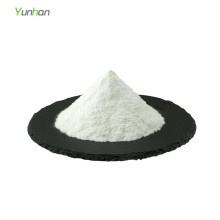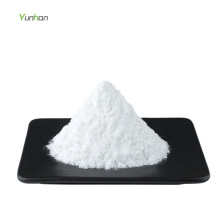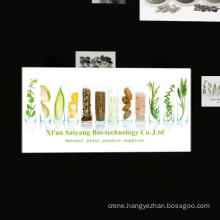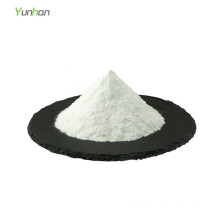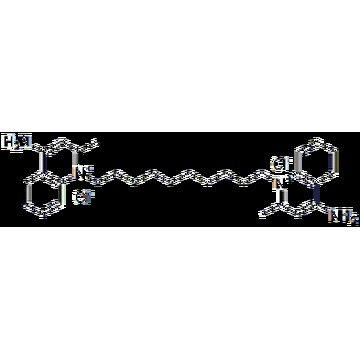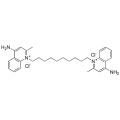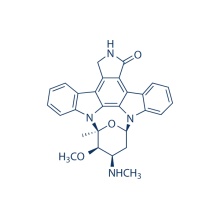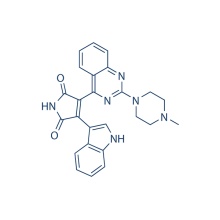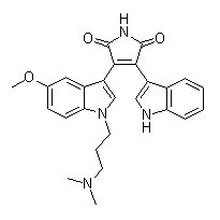Dequalinium Chloride
Product Description
.cp_wz table {border-top: 1px solid #ccc;border-left:1px solid #ccc; } .cp_wz table td{border-right: 1px solid #ccc; border-bottom: 1px solid #ccc; padding: 5px 0px 0px 5px;} .cp_wz table th {border-right: 1px solid #ccc;border-bottom: 1px solid #ccc; padding: 5px 0px 0px 5px;}
Molecular Weight:
527.57 Dequalinium Chloride is a PKC Inhibitor with IC50 of 7-18 μM, and also a selective blocker of apamin-sensitive K+ channels with IC50 of 1.1 μM.
Biological Activity
Protocol(Only for Reference)
Conversion of different model animals based on BSA (Value based on data from FDA Draft Guidelines)
For example, to modify the dose of resveratrol used for a mouse (22.4 mg/kg) to a dose based on the BSA for a rat, multiply 22.4 mg/kg by the Km factor for a mouse and then divide by the Km factor for a rat. This calculation results in a rat equivalent dose for resveratrol of 11.2 mg/kg.
Clinical Trial Information( data from http://clinicaltrials.gov, updated on 2015-02-07)
Chemical Information
Molarity Calculator
Dilution Calculator
Molecular Weight Calculator
Research Area
Customers Who Bought This Item Also Bought
Enzastaurin (LY317615)
Enzastaurin (LY317615) is a potent PKCβ selective inhibitor with IC50 of 6 nM, 6- to 20-fold selectivity against PKCα, PKCγ and PKCε. Phase 3.
ABT-263 (Navitoclax)
ABT-263 (Navitoclax) is a potent inhibitor of Bcl-xL, Bcl-2 and Bcl-w with Ki of ≤ 0.5 nM, ≤1 nM and ≤1 nM, but binds more weakly to Mcl-1 and A1. Phase 2.
Quisinostat (JNJ-26481585)
Quisinostat (JNJ-26481585) is a novel second-generation HDAC Inhibitor with highest potency for HDAC1 with IC50 of 0.11 nM, modest potent to HDACs 2, 4, 10, and 11; greater than 30-fold selectivity against HDACs 3, 5, 8, and 9 and lowest potency to HDACs 6 and 7. Phase 2.
Features:An orally bioavailable, second-generation, hydroxamic acid-based HDAC inhibitor.
GSK690693
GSK690693 is a pan-Akt Inhibitor targeting Akt1/2/3 with IC50 of 2 nM/13 nM/9 nM, also sensitive to the AGC kinase family: PKA, PrkX and PKC isozymes. Phase 1.
Ruxolitinib (INCB018424)
INCB018424 is the first potent, selective, JAK1/2 inhibitor to enter the clinic with IC50 of 3.3 nM/2.8 nM, >130-fold selectivity for JAK1/2 versus JAK3.
Pracinostat (SB939)
Pracinostat (SB939) is a potent pan-HDAC inhibitor with IC50 of 40-140 nM with exception for HDAC6. It has no activity against the class III isoenzyme SIRT I. Phase 2.
Features:A new histone deacetylase inhibitor based on hydroxamic acid, with improved physicochemical, pharmaceutical, and pharmacokinetic properties.
Tech Support & FAQs
Answers to questions you may have can be found in the inhibitor handling instructions. Topics include how to prepare stock solutions, how to store Inhibitors, and issues that need special attention for cell-based assays and animal experiments.
Contact us if you need more details on 522-51-0. We are ready to answer your questions on packaging, logistics, certification or any other aspects about Dequalinium Chloride 522-51-0、Dequalinium Chloride. If these products fail to match your need, please contact us and we would like to provide relevant information.
Molecular Weight:
527.57 Dequalinium Chloride is a PKC Inhibitor with IC50 of 7-18 μM, and also a selective blocker of apamin-sensitive K+ channels with IC50 of 1.1 μM.
Biological Activity
| Description | Dequalinium Chloride is a PKC inhibitor with IC50 of 7-18 μM, and also a selective blocker of apamin-sensitive K+ channels with IC50 of 1.1 μM. | |||||
|---|---|---|---|---|---|---|
| Targets | PKC [1] | |||||
| IC50 | 7 μM-18 μM | |||||
| In vitro | Dequalinium chloride (DECA) is a cationic, lipophilic compound with structure similar to the dye rhodamine 123. DECA is selectively accumulated and retained within the mitochondria of carcinoma cells where it acts as a mitochondrial poison by blocking mitochondrial enzymes which can then disrupt cellular energy production, eventually resulting in cell death. Dequalinium Chloride is a blocker of ganglionic transmission (EC50 = 2 μM). Dequalinium is a Potent Inhibitor of apamin-sensitive K+ channels in hepatocytes and of nicotinic responses in skeletal muscle. Dequalinium blocks angiotensin II-evoked K+ loss with an IC50 of 1.5 μM and also inhibited125I - monoiodoapamin binding with Ki of 1.1 μM. Dequalinium produces a rapid and reversible inhibition of the slow apamin-sensitive component of the afterhyperpolarization (AHP) which follows a single action potential in cultured rat sympathetic neurones. Dequalinium Chloride (DECA) is a dicationic lipophilic PKC inhibitor. When exposed to UV light, DECA covalently binds to and irreversibly inhibits PKCα and PKCβ. | |||||
| In vivo | | |||||
| Features | | |||||
Protocol(Only for Reference)
Conversion of different model animals based on BSA (Value based on data from FDA Draft Guidelines)
| Species | Baboon | Dog | Monkey | Rabbit | Guinea pig | Rat | Hamster | Mouse |
| Weight (kg) | 12 | 10 | 3 | 1.8 | 0.4 | 0.15 | 0.08 | 0.02 |
| Body Surface Area (m2) | 0.6 | 0.5 | 0.24 | 0.15 | 0.05 | 0.025 | 0.02 | 0.007 |
| Km factor | 20 | 20 | 12 | 12 | 8 | 6 | 5 | 3 |
| Animal A (mg/kg) = Animal B (mg/kg) multiplied by | Animal B Km |
| Animal A Km |
For example, to modify the dose of resveratrol used for a mouse (22.4 mg/kg) to a dose based on the BSA for a rat, multiply 22.4 mg/kg by the Km factor for a mouse and then divide by the Km factor for a rat. This calculation results in a rat equivalent dose for resveratrol of 11.2 mg/kg.
| Rat dose (mg/kg) = mouse dose (22.4 mg/kg) × | mouse Km(3) | = 11.2 mg/kg |
| rat Km(6) |
Clinical Trial Information( data from http://clinicaltrials.gov, updated on 2015-02-07)
| NCT Number | Recruitment | Conditions | Sponsor /Collaborators | Start Date | Phases |
|---|---|---|---|---|---|
| NCT01125410 | Completed | Bacterial Vaginosis | Medinova AG | January 2007 | Phase 3 |
| NCT01125410 | Completed | Bacterial Vaginosis | Medinova AG | January 2007 | Phase 3 |
Chemical Information
| Molecular Weight (MW) | 527.57 |
|---|---|
| Formula | C30H40N4.2Cl |
| CAS No. | 522-51-0 |
| Storage | 3 years -20℃Powder |
|---|---|
| 6 months-80℃in solvent (DMSO, water, etc.) | |
| Synonyms | |
| Solubility (25°C) * | In vitro | DMSO | 0.025 mg/mL ( |
|---|---|---|---|
| Water | <1 mg/mL ( | ||
| Ethanol | <1 mg/mL ( | ||
| * <1 mg/ml means slightly soluble or insoluble. * Please note that Selleck tests the solubility of all compounds in-house, and the actual solubility may differ slightly from published values. This is normal and is due to slight batch-to-batch variations. | |||
| Chemical Name | Quinolinium, 1,1'-(1,10-decanediyl)bis[4-amino-2-methyl-, chloride (1:2) |
|---|
Molarity Calculator
Dilution Calculator
Molecular Weight Calculator
Research Area
Customers Who Bought This Item Also Bought
Enzastaurin (LY317615)
Enzastaurin (LY317615) is a potent PKCβ selective inhibitor with IC50 of 6 nM, 6- to 20-fold selectivity against PKCα, PKCγ and PKCε. Phase 3.
ABT-263 (Navitoclax)
ABT-263 (Navitoclax) is a potent inhibitor of Bcl-xL, Bcl-2 and Bcl-w with Ki of ≤ 0.5 nM, ≤1 nM and ≤1 nM, but binds more weakly to Mcl-1 and A1. Phase 2.
Quisinostat (JNJ-26481585)
Quisinostat (JNJ-26481585) is a novel second-generation HDAC Inhibitor with highest potency for HDAC1 with IC50 of 0.11 nM, modest potent to HDACs 2, 4, 10, and 11; greater than 30-fold selectivity against HDACs 3, 5, 8, and 9 and lowest potency to HDACs 6 and 7. Phase 2.
Features:An orally bioavailable, second-generation, hydroxamic acid-based HDAC inhibitor.
GSK690693
GSK690693 is a pan-Akt Inhibitor targeting Akt1/2/3 with IC50 of 2 nM/13 nM/9 nM, also sensitive to the AGC kinase family: PKA, PrkX and PKC isozymes. Phase 1.
Ruxolitinib (INCB018424)
INCB018424 is the first potent, selective, JAK1/2 inhibitor to enter the clinic with IC50 of 3.3 nM/2.8 nM, >130-fold selectivity for JAK1/2 versus JAK3.
Pracinostat (SB939)
Pracinostat (SB939) is a potent pan-HDAC inhibitor with IC50 of 40-140 nM with exception for HDAC6. It has no activity against the class III isoenzyme SIRT I. Phase 2.
Features:A new histone deacetylase inhibitor based on hydroxamic acid, with improved physicochemical, pharmaceutical, and pharmacokinetic properties.
Tech Support & FAQs
Answers to questions you may have can be found in the inhibitor handling instructions. Topics include how to prepare stock solutions, how to store Inhibitors, and issues that need special attention for cell-based assays and animal experiments.
Contact us if you need more details on 522-51-0. We are ready to answer your questions on packaging, logistics, certification or any other aspects about Dequalinium Chloride 522-51-0、Dequalinium Chloride. If these products fail to match your need, please contact us and we would like to provide relevant information.
Product Categories : Cytoskeletal Signaling > PKC Inhibitor
Other Products
Hot Products
Astragaloside AChlortetracycline HCl 64-72-2Paclitaxel 33069-62-4Dexamethasone Acetate 1177-87-3Dinaciclib (SCH727965) 779353-01-4CHIR-124 405168-58-3Ro3280 1062243-51-9TAME 901-47-3CCG-1423 285986-88-110058-F4 403811-55-2Dabigatran (BIBR 953) 211914-51-1H 89 2HCl 130964-39-5T0901317 293754-55-9Aprepitant 170729-80-3Turofexorate Isopropyl (XL335) 629664-81-9BMS-378806 357263-13-9
